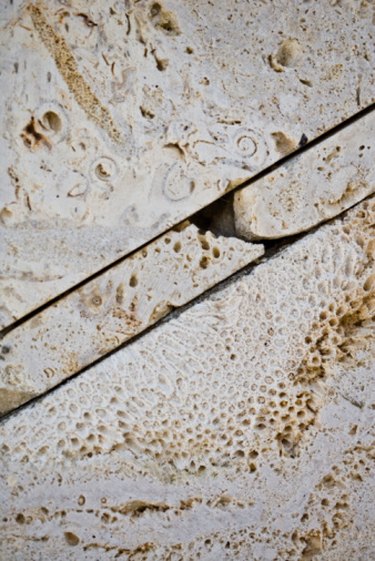
Limestone is a sedimentary rock composed of a mineral called calcite, which has the chemical formula CaCO3. Together with the dolomites, a related class of sedimentary rocks, limestone makes up some 10 to 15 percent of all sedimentary rock on our planet. Some limestone is a product of material made by living organisms; other limestone formations have inorganic origins.
Calcium
Video of the Day
The first element found in limestone is calcium; the symbol for calcium is Ca. Calcium has atomic number 20, meaning it has 20 protons in its nucleus. The pure element has 20 electrons. Like other metals in the same group, the alkaline earth metals, calcium is easily ionized, so in nature it's found as part of other compounds (like calcium carbonate). Calcium carbonate is an ionic compound, meaning that calcium has lost two electrons to become a positively charged ion, while the carbonate group has gained two electrons to become a negatively charged ion. The attraction between positive and negative charges holds the two ions together to form the crystal structure.
Video of the Day
Carbonate Ion
The carbonate ion, CO3 -2, consists of a central carbon atom surrounded by three oxygen atoms in a triangular formation. The bond angle between all three carbon to oxygen bonds is roughly 120 degrees. The negative charge is shared over all three oxygen atoms, rather than residing on any two of them. Consequently, the bonds between the carbon atom and each of the oxygen atoms are longer than a normal carbon to oxygen double bond but shorter than a normal carbon to oxygen single bond -- they are a hybrid of the two.
Chemical Reactions
The carbonate ion can accept a hydrogen ion to become bicarbonate, HCO3 with a -1 charge. The bicarbonate ion can in turn accept another hydrogen ion to become carbonic acid, H2CO3. When in water, the carbonic acid is in equilibrium with carbon dioxide in the air, so if excess carbonic acid is present, it will rapidly decompose to carbon dioxide -- the reaction that takes place when you open a soda bottle. In limestone, however, the attraction between the calcium and carbonate ions is strong enough that calcium carbonate does not dissolve in neutral solutions. It only dissolves readily in acidic solutions. Adding hydrochloric acid to limestone, for example, will rapidly cause it to fizz.
Origins and Fate
The calcium carbonate in limestone is often formed by organisms like corals, which make hard shells for themselves out of this material. Chalk is another form of limestone that has similar origins. Limestone may also develop from dripping water in caves; the water carries dissolved calcium carbonate, which precipitates to form a kind of limestone called travertine. If buried deep and subjected to high heat and pressure, limestone can become a kind of metamorphic rock called marble.